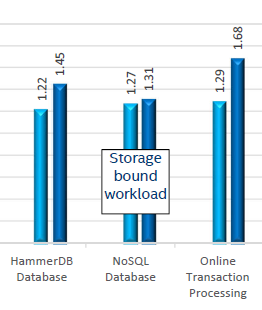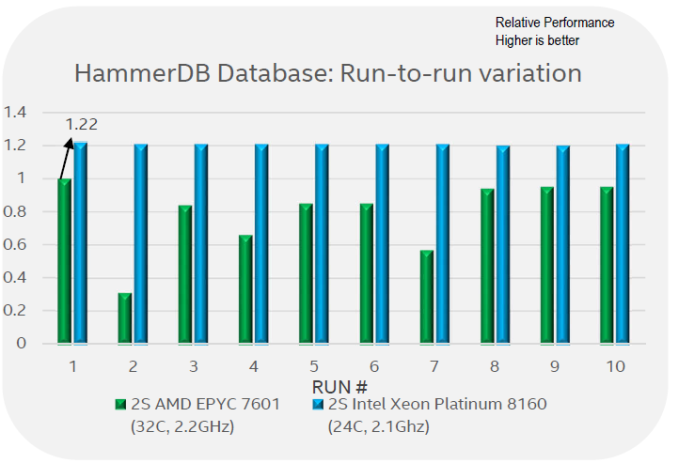Dissecting Intel's EPYC Benchmarks: Performance Through the Lens of Competitive Analysis
by Johan De Gelas & Ian Cutress on November 28, 2017 9:00 AM EST- Posted in
- CPUs
- AMD
- Intel
- Xeon
- Skylake-SP
- Xeon Platinum
- EPYC
- EPYC 7601
Database Performance & Variability
Results are very different with respect to transactional database benchmarks (HammerDB & OLTP). Intel's 8160 has an advantage of 22 to 29%, which is very similar to what we saw in our own independent benchmarking.
One of the main reasons is data locality: data is distributed over the many NUMA nodes causing extra latency for data access. Especially when data is locked, this can cause performance degradation.
Intel measured this with their own Memory Latency Checker (version 3.4), but you do not have rely on Intel alone. AMD reported similar results on the Linley Processor conference, and we saw similar results too.
There is more: Intel's engineers noticed quite a bit of performance variation between different runs.
Intel engineers claim that what they reported in the first graph on this page is, in fact, the best of 10 runs. Between the 10 runs, it is claimed there was a lot of variability: ignoring the outlier number 2, there are several occasions where performance was around 60% of the best reported value. Although we can not confirm that the performance of the EPYC system varies precisely that much, we have definitely seen more variation in our EPYC benchmarks than on a comparable Intel system.













105 Comments
View All Comments
Johan Steyn - Monday, December 18, 2017 - link
I am so glad people are realising ANandtechs rubish, probably led by Ian who wrote that terrible Threadripper review. Maybe he will realise it as more complain. It all depends on how much Intel is paying him...mapesdhs - Wednesday, November 29, 2017 - link
ANSYS is one of those cases where having massive RAM really matters. I doubt if any site would bother speccing out a system properly for that. One ANSYS user told me he didn't care about the CPU, just wanted 1TB RAM, and that was over a decade ago.rtho782 - Tuesday, November 28, 2017 - link
> Xeon Platinum 8160 (24 cores at 2.1 - 3.7 GHz, $4702k)$4,702,000? Intel really have bumped up their pricing!!
bmf614 - Tuesday, November 28, 2017 - link
The pricetag discussion really needs to include software licensing as well. Windows Datacenter and SQL server on a machine with 64 cores will cost more than the hardware itself. This is the reason that the Xeon 5122 exists.bmf614 - Tuesday, November 28, 2017 - link
Also isnt it kind of silly to invest in a server platform with limited PCIE performance when faster and faster storage and networking is becoming commonplace?Polacott - Tuesday, November 28, 2017 - link
it really seems that AMD has crushed Intel this time. Also Charlie has some interest points about security ( has this topic being even analyzed here ? https://www.semiaccurate.com/2017/11/20/epyc-arriv... )Software WILL be tuned for Epyc, so a safe bet will not be getting Xeon but Epic, for sure.
And power consumption and heat is really important as is an interesting part of datacenter maintenance costs.
I really don't get how the article ends up in this conclusion.
Johan Steyn - Monday, December 18, 2017 - link
Intel's financial support helps them reach this conclusion. Very sadZolaIII - Tuesday, November 28, 2017 - link
As usually Intel cheated. Clients won't use neither their property compiler nor a software but GNU one's. Now let me show you a difference:https://3s81si1s5ygj3mzby34dq6qf-wpengine.netdna-s...
Other than that this is boring as ARM NUMA based server chips are coming with some backup from good old veterans when it comes to to supercomputing and this time around Intel won't have even a compiler advantage to drag about it.
Sources:
https://www.nextplatform.com/2017/11/27/cavium-tru...
http://www.cavium.com/newsevents-Cray-Catapults-Ar...
Now this are the real news & melancholic ones for me as it brings back memories how it all started. & guess what? We are back their on the start again.
toyotabedzrock - Tuesday, November 28, 2017 - link
Linux 4.15 has code to increase EPYC performance and enable the memory encryption features. 4.16 will have the code to enable the virtual machine memory encryption.duploxxx - Friday, December 1, 2017 - link
thx for sharing the article Johan, as usual those are the ones I will always read.Interesting to get feedback from Intel on benchmark compares, this tells how scared they really are from the competition. There is no way around, I' ve been to many OEM and large vendor events lately. One thing is for sure, the blue team was caught with there pants down and there is for sure interest from IT into this new competitor.
Now talking a bit under the hood, having had both systems from beta stages.
I am sure Intel will be more then happy to tell you if they were running the systems with jitter control. Off course they wont tell the world about this and its related performance issues.
Second, will they also share to the world that there so called AVX enhancement have major clock speed disadvantages to the whole socket. really nice in virtual environments :)
Third, the turbo boosting that is nowhere near the claimed values when running virtualization?
Yes the benchmarking results are nice, but they don't give real world reality, its based on synthetic benches. Real world gets way less turbo boost due to core hot spots and there co-related TDP.
There are reasons why large OEM did not yet introduce EPYC solutions, they are still optimizing BIOS and microcode as they want to bring a solid performing platform. The early tests from Intel show why.
Even the shared VMware bench can be debated with no shared version info as the 6.5u1 has got major updates to the hypervisor with optimizations for EPYC.
Sure DB benches are an Intel advantage, there is no magic to it looking at the die configurations, there are trade offs. But this is ONLY when the DB are bigger then certain amount of dies so we are talking here about 16+ cores from the 32 cores/socket systems for example, anything lower will have actually more memory bandwidth then the Intel part. So how reliable are these benchmarks for a day to day production.... not all are running the huge sizes. And those who do should not just compare based on synthetical benches provided but do real life testing.
Aint it nice that a small company brings a new CPU line and already Intel needs to select there top bin parts as a counter part to show benchmarks to be better. There are 44 other bins available on the Intel portfolio, you can probably already start guessing how well they really fare against there competitor....